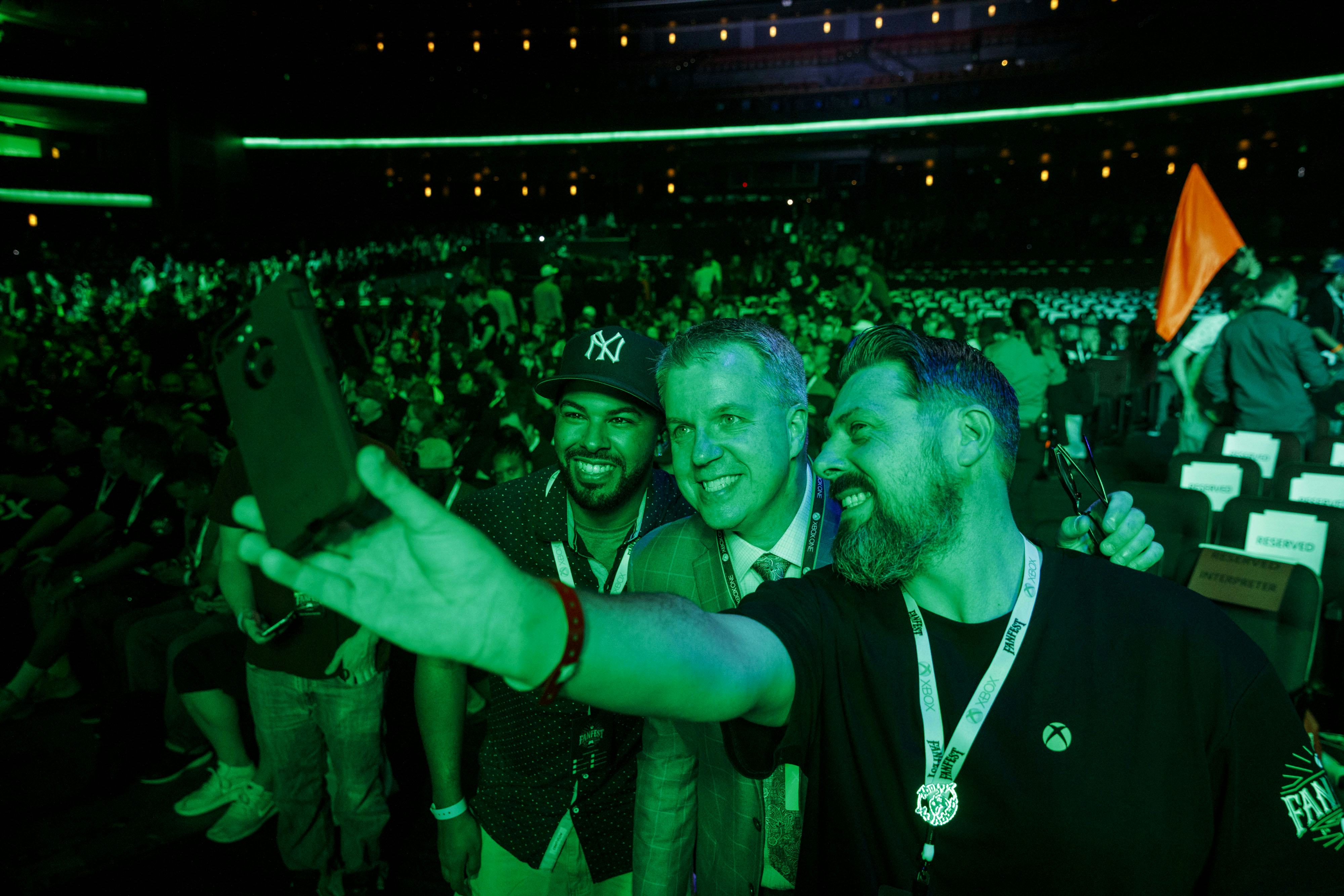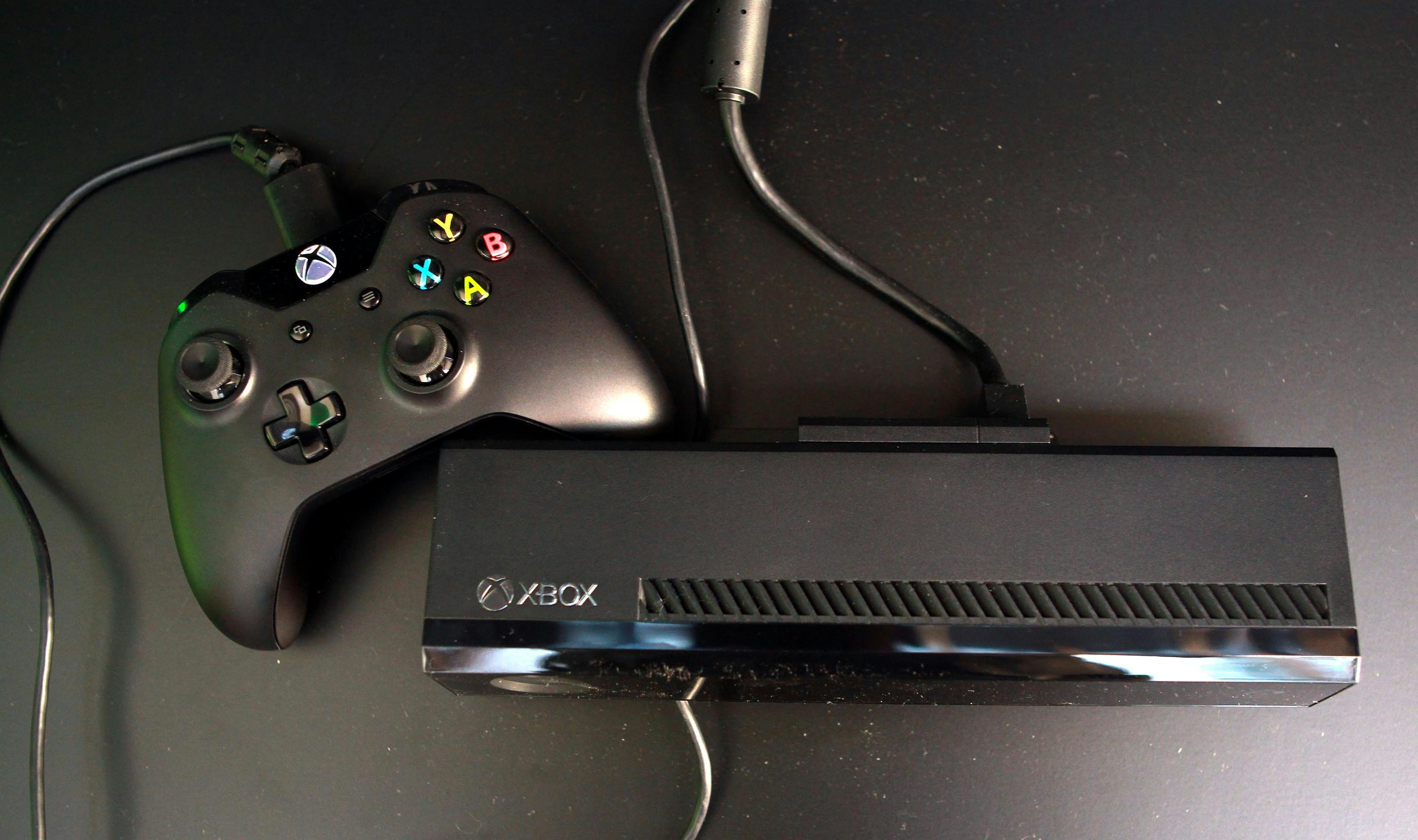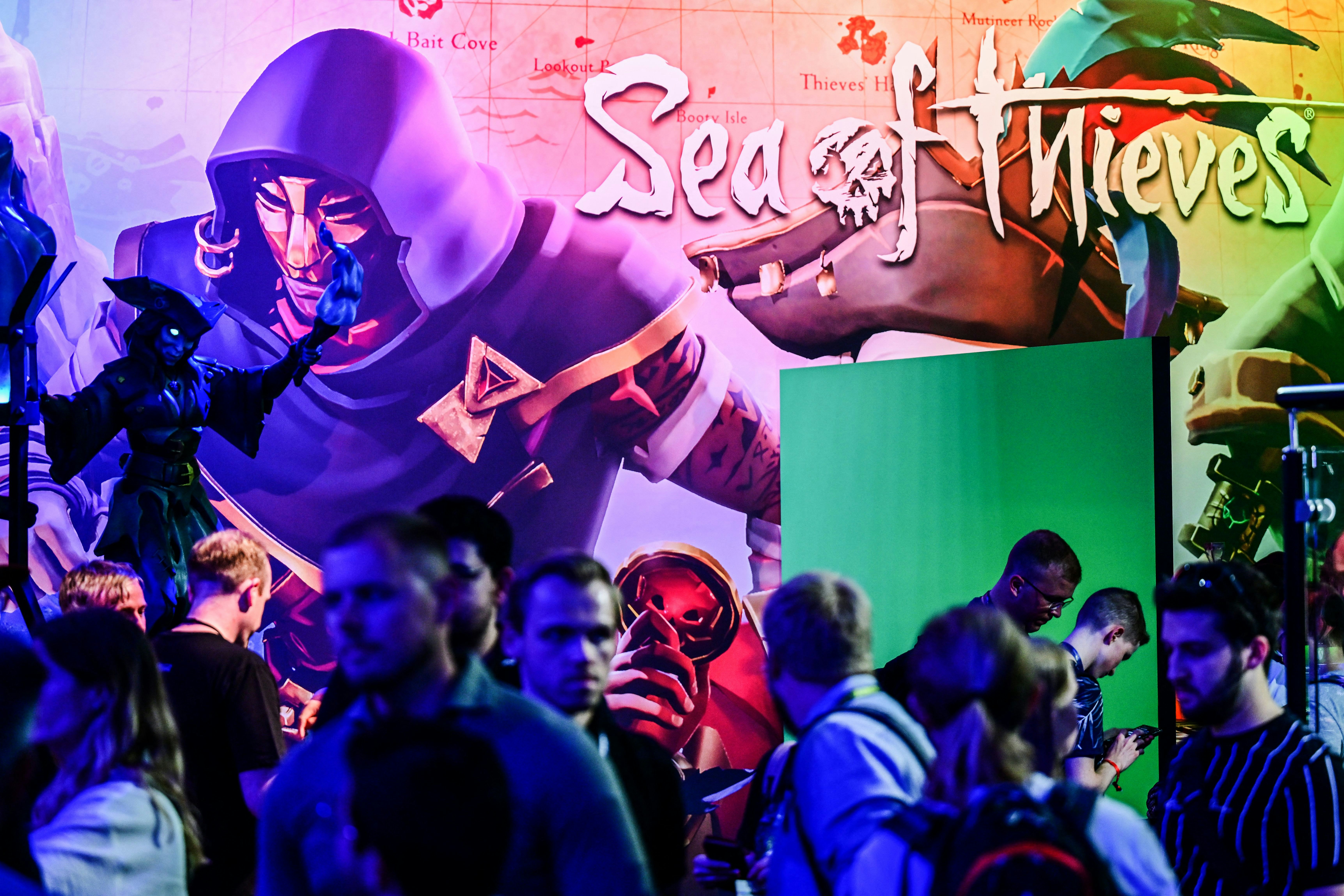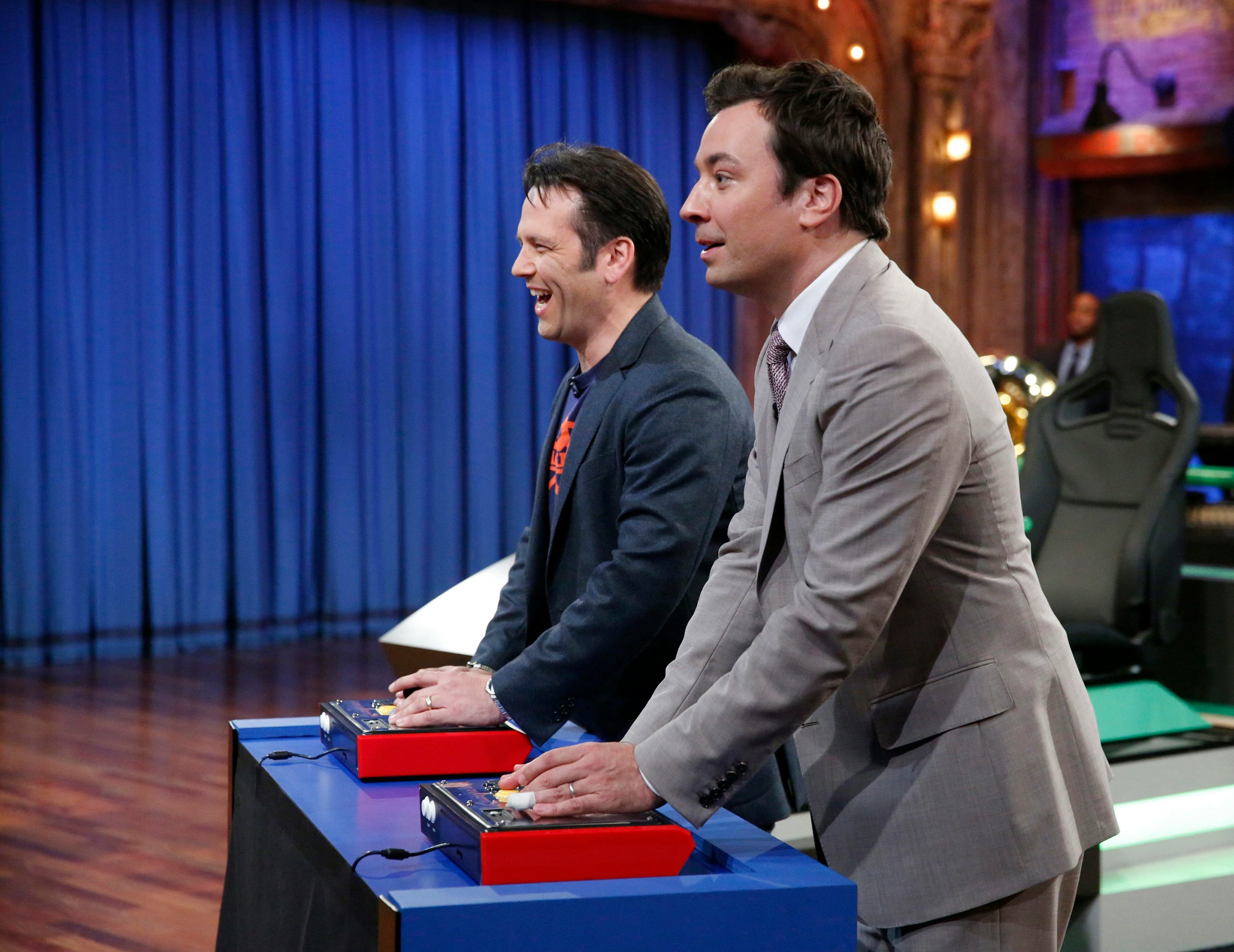
In November 2014, Larry “Major Nelson” Hryb walked into a Microsoft conference room and picked up a controller. Running on a PC in front of him was a crude prototype for one of the most important Xbox games of the decade: an online multiplayer pirate adventure set on a vast open ocean.
“The shark was like a square with another big square on top of it,” Hryb, a former senior comms director at Xbox, tells Inverse, “but it was a proof of concept.” At the time, they called it Athena.
That game would go on to become Rare’s Sea of Thieves, an Xbox exclusive and one of the first titles ever released for Game Pass. Hryb still considers that demo one of his favorite memories from two decades spent at Xbox, but it also marked a turning point for a company struggling to win over gamers a year after the release of the Xbox One. Microsoft execs boarded pirate ships, sailed from island to island collecting coconuts and working as a cohesive crew, and dreamed of the possibilities.
Looking back now, a full 10 years on from the launch of Xbox One on November 22, 2013, that piece of hardware has largely faded from the conversation. Like Nintendo’s Wii U, it’s bound to be remembered as a disappointment when compared to its successor (and predecessor). Yet the story of the Xbox One generation is one of big swings and, ultimately, redemption.
A Rocky Launch

Plenty has been said about the disastrous unveiling of the One. In May of 2013, former Xbox head Don Mattrick welcomed fans and press from around the world to Microsoft’s Redmond campus. After the golden years of the Xbox 360, Microsoft was headed into the announcement of its next console full of confidence and imbued with momentum. The company even partnered with Steven Spielberg to bring its beloved Halo franchise to television (a project that wouldn’t bear fruit until 2022). Microsoft was at the forefront of advances in cloud computing, motion controls, and streaming entertainment. Mattrick was unconvinced that concepts like backward compatibility and offline play were important selling points in 2013, and the profit potential of digital game sales had Microsoft’s leadership seeing dollar signs. Netflix, digital video, and downloadable game content had been nothing short of revolutionary on the 360’s marketplace. To hell with old-fashioned ideas of what a video game console should be. Unfortunately, the core audience disagreed.
“That day was very difficult,” Hryb recalls. “For a lot of different reasons, one of which was that the messaging wasn’t quite tight. There were a lot of questions: ‘What if — what about this?’ And some of the questions were being answered, but some of them we just didn’t have answers for yet. So it was a real struggle. Our message for the Xbox 360 generation was very clear, and now we were in a different position.”
“A lot of people didn’t really understand what we were trying to do.”
Even among the Xbox faithful, consumers were not thrilled about the prospect of an “always online” TV device that happened to run games. The new era had its quirks. If you were buying a game on a disc, why would it need to be installed before you can play it? What if you wanted to share a game with a family member or friend? What would happen if I wanted to trade in my discs to GameStop down the road? The notion of digital games being sold directly through the console’s dashboard, not unlike Steam, only muddied the waters further. “That was a real growing pain,” Hryb says. Maybe worst of all, Sony would be selling its PS4 for $399 — a hundred bucks less than Microsoft’s offering.
In hindsight, much of Mattrick’s vision for the machine codenamed “Durango” — the potential of the Kinect, the vast power of Microsoft Azure’s cloud technology — was ahead of its time. But in the moment, gamers just saw it as being out of touch.
“A lot of people didn’t really understand what we were trying to do,” says Hryb. “I’m a hardcore nerd, and I was really excited about the architecture that we were using. Which, frankly, we’re using up until the Series X and S. It’s actually running virtual machines inside of it, which allows a lot of the flexibility and the hot-swapping and a lot of things we take for granted today.”

In a few short years, this VM software would add two key pillars to Xbox’s business strategy. In the meantime, however, players weren’t sold on the benefits of the Xbox One’s under-the-hood trade-offs. Skype conferencing, TV integration, and similar bells and whistles weren’t going to move units. But some kickass games might.
For a certain kind of person, buying an Xbox One was a foregone conclusion. The One was, after all, the only console that would end up getting Halo 5. So when I walked into the Peoria, Illinois, Best Buy a couple days after Christmas 2013, with cash and a credit card application, it was inevitable I’d leave with the new Xbox. I picked up Battlefield 4, which I loved; Call of Duty: Ghosts, which I didn’t care for; and Assassin’s Creed: Black Flag, which I liked but resented for not being a new Splinter Cell. Fast-forward a decade, and that heavy black slab is still kicking. It sits in my daughter’s bedroom, a perfectly adequate all-in-one solution for her entertainment needs. It also represents ten thousand or so hours of my life, immeasurable joy, and uncounted memories. I’d be lying if I said it wasn’t my favorite console ever.
A Work in Progress

Battlefield and Respawn’s original Titanfall held my interest pretty well for the first year. And I appreciated the design of the hardware itself. It looked more like a DVD player than even the PlayStation 2 — a real departure from the 360’s almost toylike white-and-chrome flair. (I had replaced the front of my 360 with an Optimus Prime faceplate.) I confess to having no memory of using the Kinect for games on the One. Its voice commands were simply a convenient way to turn the machine on or off and capture gameplay clips. (“Xbox, record that!”)
“There was a tremendous amount of evolution during the Xbox One era. Some of it worked out great — like the Adaptive Controller — and some of it, like the Kinect, didn’t,” Hryb says. “That came along late in the 360 generation, and there was the decision to include it as part of Xbox One, to have some motion-control support. Not only on the operating system level but within the games as well. So that was something that the community wasn’t ready for or didn’t want to embrace. And, frankly, maybe we didn’t provide the best solution for them in terms of the kįller app.”
From the Kinect to the team that launched the Adaptive Controller for accessibility in 2018, that spirit of innovation is a big part of what defined the generation. Microsoft is first and foremost a software company, and the countless, sometimes monthly, firmware updates along the way helped reshape the One into the box players wanted it to be.
“We kind of put our arm around the audience and said, ‘Come on the journey with us,’” says Hryb. “We started using ‘user voice’ at that point and having people upvote features and things along those lines. Nobody really was doing that at that scale, back in the day, on a consumer electronic item.”

You can see some of this in the more inclusive vibe of the brand these days — to an extent, Xbox has traded chainsaw bayonets and desaturated warzones for a much wider, more vibrant catalog. That part of Don Mattrick’s vision for the platform — welcoming as many different kinds of users as possible — endures. But after Mattrick’s successor, Phil Spencer, took the reins as head of Xbox in 2014, a few significant things happened: Microsoft acquired Mojang, the Swedish studio behind Minecraft, which by that point had sold 50 million copies across PC, smartphones, and consoles; the Kinect ceased to be a mandatory purchase, which lowered the price of the system; the big push into TV was replaced, in a sense, with the ID@Xbox program, intended to make the console more attractive to indie developers; and a smaller, updated version of the console, called the One S, arrived in 2016, followed by a high-end model called the Xbox One X a year later.
“Everything was changing,” Hryb says. “Mobile was now bigger than ever, with the launch of the iPhone and the Android and the Windows Phone (there are still a lot of people who loved their Windows Phone back in the day, and I did too). Mobile was so important, and so gaming just started to fracture in so many different ways. We had iPads in the 360 era, but they were really picking up steam as those other consoles were launching in 2013-ish. That helped bring focus to what we needed to do to create a great console gaming experience at Xbox. Because it was just such a different landscape from the 360. It was a time of growth and experimentation like I had never seen before.”
Spencer’s public persona is more or less that of your average, decent gamer. It’s easy to be charmed by his love for Halo or his undying sentimentality toward the earliest days of the Xbox. So when he showed up at E3 2015 boasting about “the greatest games lineup in Xbox history,” it felt like a well-deserved (and much-needed) comeback. The Xbox One had stumbled in its first year, and Halo: The Master Chief Collection caused a debacle of its own in late 2014 when it debuted with a broken matchmaking system that made multiplayer unplayable. (“I have not spent a single day since the night the game fell down in matchmaking where I didn’t think about it,” former Halo creative director Frank O’Connor wrote several years later.)
With the dust settled, despite the missteps and godawful luck of the Xbox One’s first couple years, I’d say that “greatest games lineup” slogan rings true. I had the time of my life with the original Destiny, Black Ops III, Fallout 4, and other third-party games early on, and by late 2015 Microsoft began dropping some heavy hitters, including Quantum Break, Rise of the Tomb Raider, Halo 5: Guardians, Forza 6, Halo Wars 2, and Sea of Thieves.

As the Xbox One matured under Spencer’s leadership, the messaging around Microsoft’s gaming ecosystem underwent some radical changes. Project xCloud, an offshoot of the virtual machine technology that had powered the console from its infancy, promised to deliver games to players on more devices than ever before. Eventually, in the summer of 2017, the company launched Xbox Game Pass, a subscription-based service that offered a library of games for a monthly fee not dissimilar to what Netflix and its competitors had done in film and TV. Meanwhile, Azure’s VM tech powered another defining feature of the One generation: backward compatibility.
“The engineers and the wizards who worked on that realized, with the 360 and even going back to the OG, we had this library of games we could have access to,” says Hryb. “And through all the research, we saw that backcompat, at that point, was very important for gamers. They wanted to play some of the games that they owned, whether they were digital or physical.”
Many of the most treasured classics from throughout Xbox history — The Elder Scrolls III: Morrowind, Star Wars: Knights of the Old Republic, Red Dead Redemption — were made available on Xbox One. Today, with the Xbox Series X and Series S, that same three-generation library persists, playable whether you’re on a 2013 console or one bought in 2023. A massive undertaking, no doubt, but it means the collection of discs I held onto for 22 years still matters to modern hardware. And new or younger players can discover these games for themselves through the Microsoft Store.
The Legacy of Xbox One

In the current gen, we take for granted the high number of multiplayer games that offer cross-platform play. I can jump into Fortnite with friends regardless of whether I’m on Steam, Game Pass, Nintendo Switch, PS5, mobile, or my Series X. I might have to go through one or two extra steps to link up with my squad, but the choice between Xbox, PlayStation, or PC isn’t as big a deal anymore.
“When I was at Microsoft, I always used to kid that Windows was our other gaming platform, when in fact it’s the largest gaming platform,” Hryb says. “So I think that Xbox finally looked at it and said, ‘Wait a minute. We have this tremendous asset in Windows gaming. Let’s put our arms around it and bring it all together, and up-level everything.’ Everything seems obvious in the rearview mirror, but when you look at it now, it makes perfect sense: we wanted people to play wherever they want.”
Xbox’s willingness to blur the boundaries between platforms, as it did with Minecraft in 2017, has had a ripple effect across the industry. In another decade, that may be the Xbox One’s real legacy.







